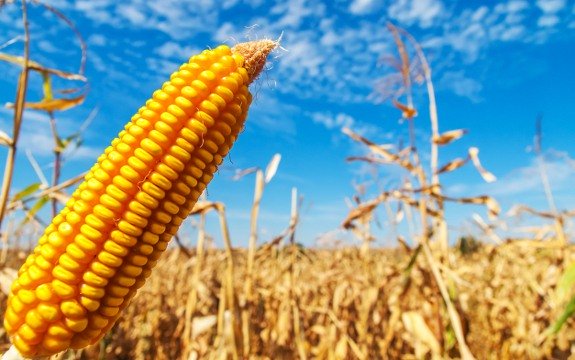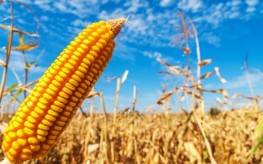‘Organic Ready’ Corn to Replace Monsanto’s GMO Corn, Cross-Pollination

 Here’s some of the best news all year for non-GMO supporters. Frank Kutka is working to save our heirloom corn from cross-breeding with genetically modified corn. He’s been diligently at work for over 15 years now developing what he calls “Organic Ready” corn varieties that have the ability to block cross-pollination, thus eliminating Monsanto’s prevalently grown GMO corn from infesting organic farmer’s crops.
Here’s some of the best news all year for non-GMO supporters. Frank Kutka is working to save our heirloom corn from cross-breeding with genetically modified corn. He’s been diligently at work for over 15 years now developing what he calls “Organic Ready” corn varieties that have the ability to block cross-pollination, thus eliminating Monsanto’s prevalently grown GMO corn from infesting organic farmer’s crops.
Kutka says:
“We need corn that organic farmers can grow without fear of GMO contamination,” says Kutka, who is in the fourth year of a five-year breeding project funded by the Organic Farming Research Foundation.”
Needless to say, Kutka, like all farmers growing organic crops, faces an enormous challenge. U.S. farmers currently plant millions of acres of GMO corn, among other GMO crops. Around 93% of the year’s corn crop was genetically modified.
While this makes Monsanto happy, it leaves those looking for non-contaminated, heirloom, organic, non-GMO corn a little miffed, to say the least. These millions of acres of corn can also easily contaminate other crops – including those which are not even corn, just because mother nature continues to work. GMO genes cross over into other plants, causing them to contain variant DNA like the mother plant. This is many argue that GMO crops must be banned, and that GMO labeling simply isn’t enough.
Kutka’s research concentrates on gametophytic incompatibility to protect his organic corn. By focusing on naturally occurring traits and the ancient grain teosinte that make it difficult for GMO pollen to enter the corn silks, thus preventing cross-pollination, he hopes to make his corn incompatible with GMO cross-breeding.
There are already some plants that have a natural resistance to GMO cross-breeding, like sunflowers, and this is why there is a huge demand for organic sunflower oil at this time – it is most assuredly not contaminated with GMO genes.
Kutka’s research has narrowed in on a trait is known as gametophytic incompatibility, or Ga1S, though it is not a new discovery.
He states:
“The trait has been known and used for decades. It was first used in popcorn in the 1950s and then in white corn varieties in the 1970s. It’s not a perfect system, but it greatly reduces the risk of out-crossing.”
Additionally, Kutka is looking into another pollen block trait—Ga2S, which is found in teosinte, an ancestor of maize. He has been attempting to create his ‘Organic Ready’ corn since 2011 utilizing pollen-blocking traits, a play on Monsanto’s ‘Round Up Ready’ corn, since he was a student at Cornell University.
The USDA National Organic Program, which requires all organic farmers to go through expensive and time-consuming testing to make sure their crops are organic (while Monsanto and their ilk can more easily sell potentially dangerous man-made creations), currently prohibits GMOs in organic production, yet there are no regulations to protect farmers from Monsanto’s GMO corn when it becomes contaminated by pollination, wind, or other of nature’s causes.
Organic and non-GMO farmers have suffered huge losses for this reason, while Monsanto continues to sue farmers who try to save GMO seed, calling their crops ‘proprietary.’
A recent survey of organic farmers from 17 states, predominantly in the Midwest, shows 67% of farmers planned to delay planting corn this year so their crops would pollinate later than their neighbors’ GM corn, at an average cost of $16,000. Delaying the growing season is just one expense organic farmers have to contend with in competition with corporate seed monopolies.
Heirloom seed companies such as Missouri-based Baker Creek Heirloom Seeds has lost one-half of its heirloom varieties to GMO contamination, too, and they are not alone in this dilemma. It is due to these challenges that Kutka feels inspired to continue his work:
“I’m working on developing varieties that hopefully will work in a lot of different locations in the U.S.”
He realizes that time is of the essence if any heirloom corn is to remain.
He is working with another corn breeder, Dave Christensen, to breed the pollen-blocking trait into a Painted Mountain Corn variety that grows in the harsh dry mountainous regions of the West. Another corn breeder, Major Goodman at North Carolina State University, is developing pollen-blocking organic corn varieties for Southern growing regions.
He hopes to deliver his ‘Organic Ready’ corn by 2015.

Absolutely frightening !
Wooo, Alan Smith- nice way to alienate anyone with your hate speech. For anyone who wants to know the real human, environmental, water damage done by endocrine disruptor pesticides (like Roundup, Enlist, Dicamba) here’s some reading for you- some of the many references from the book I’m researching and writing
1b FAILURE TO YIELD- Evaluating the Performance of
Genetically Engineered Crops
http://www.ucsusa.org/sites/default/files/legacy/assets/documents/food_and_agriculture/failure-to-yield.pdf
http://www.isaaa.org/resources/publications/pocketk/1/http://www.unep.org/dewa/agassessment/reports/IAASTD/EN/Agriculture%20at%20a%20Crossroads_Synthesis%20Report%20%28English%29.pdf.
And 6 http://www.globalonenessproject.org/sites/default/files/downloads/IAASTD%20Fact%20Sheet.pdf
1c http://American Academy of Environmental Medicine http://www.aaemonline.org/gmopost.html
1d Seralini Study: Actual report download with links to critical feeback by Monsanto interest groups etc. and references: http://www.herbogeminis.com/IMG/pdf/roundup_toxicity_seralini-2.pdf
Seralini Studies: ScienceDirect
http://www.ijbs.com/v05p0706.htm
http://www.gmo-compass.org/eng/news/messages/200703.docu.html
http://zcomm.org/zmagazine/three-approved-gmos-linked-to-organ-damage-by-rady-ananda/
Monsanto
Studies: ScienceDirect
http://www.sciencedirect.com/science/article/pii/S0278691504000547
http://www.sciencedirect.com/science/article/pii/S0278691505001985
http://www.sciencedirect.com/science/article/pii/S0278691506000093
1d SCIENTIFIC
REPORT OF EFSA- Considerations on the applicability of OECD TG 453 to whole
food/feed testing http://www.efsa.europa.eu/en/efsajournal/doc/3347.pdf 1dd
http://www.efsa.europa.eu/en/efsajournal/doc/3347.pdf
1e David Schubert, personal communication to H.
Penfound, Greenpeace Canada, October 25, 2002.
1f Irina
Ermakova, “Genetically modified soy leads to the decrease of weight and high mortality of rat pups of the first generation. Preliminary studies,” Ecosinform 1 (2006): 4–9.
1g Irina Ermakova, “Experimental Evidence of GMO Hazards,” Presentation at Scientists for a GM Free Europe, EU Parliament, Brussels, June 12, 2007
1h L. Vecchio et al, “Ultrastructural Analysis of Testes from Mice Fed on Genetically Modified Soybean,” European Journal of Histochemistry 48, no. 4 (Oct–Dec 2004):449–454.
1i Oliveri et al., “Temporary Depression of Transcription in Mouse
Pre-implantion Embryos from Mice Fed on Genetically Modified Soybean,”
48th Symposium of the Society for Histochemistry, Lake Maggiore (Italy),
September 7–10, 2006.
1j Alberta Velimirov and Claudia Binter, “Biological effects of transgenic
maize NK603xMON810 fed in long term reproduction studies in mice,”
Forschungsberichte der Sektion IV, Band 3/2008
1k Jerry Rosman, personal communication, 2006
1l See for example, A. Dutton, H. Klein, J. Romeis, and F. Bigler, “Uptake of Bt-toxin by herbivores feeding on transgenic maize and consequences for the predator Chrysoperia carnea,” Ecological Entomology 27 (2002): 441–7; and
J. Romeis, A. Dutton, and F. Bigler, “Bacillus thuringiensis toxin
(Cry1Ab) has no direct effect on larvae of the green lacewing Chrysoperla carnea (Stephens) (Neuroptera: Chrysopidae),” Journal of Insect Physiology 50, no. 2–3 (2004): 175–183.
1m Washington State Department of Health, “Report of health surveillance activities: Asian gypsy moth control program,” (Olympia, WA: Washington State Dept. of Health, 1993).
1n M. Green, et al., “Public health implications of the microbial pesticide Bacillus thuringiensis: An epidemiological study, Oregon, 1985-86,” Amer. J. Public Health 80, no. 7(1990): 848–852.
1o Ashish
Gupta et. al., “Impact of Bt Cotton on Farmers’ Health (in Barwani and Dhar District of Madhya Pradesh),” Investigation Report, Oct–Dec 2005.
So it took him 15 years to do what Monsanto does in just a few swipes with a gene splicer. Big deal. Genetic modification is genetic modification.
Ironically, the breeding of this corn is also genetic modification and American corn is basically genetically modified grass.
Wrong. Genetic engineering is the process of manually
adding new DNA to an organism. The goal is to add one or more new
traits that are not already found in that organism. Selective breeding is not GE.